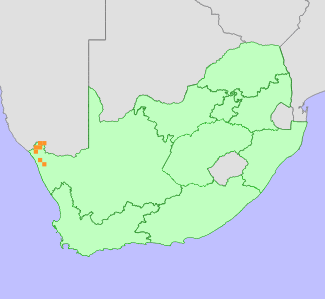|
Scientific Name | Cyrtanthus herrei (F.M.Leight.) R.A.Dyer |
Higher Classification | Monocotyledons |
Family | AMARYLLIDACEAE |
Synonyms | Cryptostephanus herrei F.M.Leight., Cryptostephanus merenskyanus Dinter & G.M.Schulze |
National Status |
Status and Criteria | Near Threatened B1ab(iii,v)+2ab(iii,v) |
Assessment Date | 2022/05/10 |
Assessor(s) | D.A. Snijman, D. Raimondo & L. von Staden |
Justification | This species has a limited distribution and has an extent of occurrence of 2682 km² and an area of occupancy of 76 km². It is known from 12 locations which are declining due to illegal collecting of wild plants for the specialist horticultural trade. With the population declining but with more than 10 locations extant it almost reaches the thresholds for listing as Vulnerable under criterion B and is assessed as Near Threatened. |
Distribution |
Endemism | Not endemic to South Africa |
Provincial distribution | Northern Cape |
Range | This species' distribution stretches from Harrasberg, northern Namaqualand, Richtersveld and Numees in the Northern Cape Province of South Africa to southern Namibia. |
Habitat and Ecology |
Major system | Terrestrial |
Major habitats | Goariep Mountain Succulent Shrubland, Central Richtersveld Mountain Shrubland, Stinkfonteinberge Quartzite Fynbos, Lekkersing Succulent Shrubland, Die Plate Succulent Shrubland, Namaqualand Klipkoppe Shrubland |
Description | Plants are found in deeply shaded rock ledges and screes on south-facing rocky slopes. They can occur in quartzite or granite. |
Threats |
| This species is long-lived and slow growing. The population is declining rapidly as a result of illegal collection with 17 plants included in confiscations between March 2019 and December 2021, many more are likely to have been removed from the wild but not intercepted by law enforcement efforts. Mature bulbs are often advertised for sale, and can fetch up to 80 Pounds. Plants have disappeared from accessible sites close to roads. |
Population |
It is known from a large number of records along the central mountains of the Richtersveld, but subpopulations tend to be small, consisting of only a few plants.
|
Population trend | Decreasing |
Conservation |
| This species is conserved in the Richtersveld National Park. |
Assessment History |
Taxon assessed |
Status and Criteria |
Citation/Red List version | | Cyrtanthus herrei (F.M.Leight.) R.A.Dyer | NT B1ab(v) | Raimondo et al. (2009) | | Cyrtanthus herrei (F.M.Leight.) R.A.Dyer | Lower Risk - Near Threatened | Victor (2002) | | Cyrtanthus herrei (F.M.Leight.) R.A.Dyer | Rare | Hilton-Taylor (1996) | | Cyrtanthus herrei (F.M.Leight.) R.A.Dyer | Rare | Hall et al. (1980) | |
Bibliography |
Dyer, R.A. 1959. Cyrtanthus herrei. Flowering Plants of Africa 33:t. 1281.
Hall, A.V., De Winter, M., De Winter, B. and Van Oosterhout, S.A.M. 1980. Threatened plants of southern Africa. South African National Scienctific Programmes Report 45. CSIR, Pretoria.
Hilton-Taylor, C. 1996. Red data list of southern African plants. Strelitzia 4. South African National Botanical Institute, Pretoria.
Raimondo, D., von Staden, L., Foden, W., Victor, J.E., Helme, N.A., Turner, R.C., Kamundi, D.A. and Manyama, P.A. 2009. Red List of South African Plants. Strelitzia 25. South African National Biodiversity Institute, Pretoria.
Reid, C. and Dyer, R.A. 1984. A review of the southern African species of Cyrtanthus. The American Plant Life Society, La Jolla, California.
Snijman, D.A. 2013. Plants of the Greater Cape Floristic Region 2: The extra Cape flora. Strelitzia 30. South African National Biodiversity Institute, Pretoria.
Victor, J.E. 2002. South Africa. In: J.S. Golding (ed), Southern African plant Red Data Lists. Southern African Botanical Diversity Network Report 14 (pp. 93-120), SABONET, Pretoria.
|
Citation |
| Snijman, D.A., Raimondo, D. & von Staden, L. 2022. Cyrtanthus herrei (F.M.Leight.) R.A.Dyer. National Assessment: Red List of South African Plants version 2024.1. Accessed on 2025/12/07 |
 Comment on this assessment
Comment on this assessment


